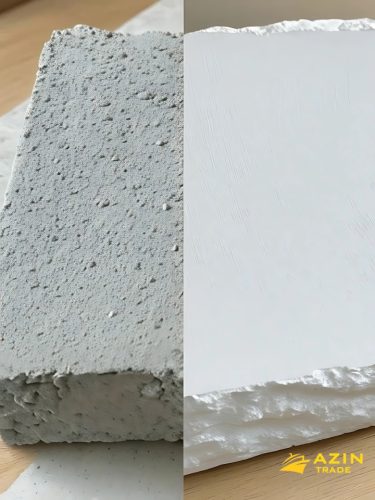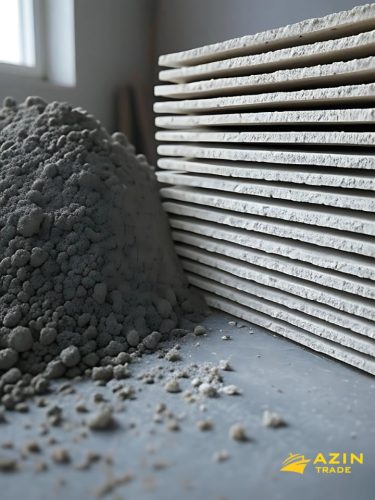Cement and gypsum are two fundamental materials extensively utilized in the construction industry. While both have critical roles, they serve distinct purposes and possess unique properties that affect their applications and performance. Understanding these differences is essential for making informed decisions in material selection, ensuring quality, durability, and safety in construction projects.
Overview of Cement
Cement is a versatile binding agent that hardens when mixed with water, forming a solid and durable substance ideal for concrete and mortar. The most commonly used type is Portland cement, which is created by heating a mixture of limestone and clay to high temperatures in a kiln. This process produces clinker, which is then finely ground into a powder. Portland cement is renowned for its strength and durability, making it suitable for load-bearing structures that can withstand heavy loads and environmental stressors.
The hydration process of cement involves complex chemical reactions that occur when water is added. These reactions lead to the formation of calcium silicate hydrate (C-S-H) and calcium hydroxide, which provide the hardened structure with its strength. The compressive strength of cement can reach up to 40 MPa (megapascals) in standard mixes, making it ideal for a wide range of construction applications.
Overview of Gypsum
Gypsum is a soft mineral composed of calcium sulfate dihydrate (CaSO₄·2H₂O). It is primarily utilized to produce drywall, plaster, and various other building materials. Gypsum is favored for its fire-resistant properties, making it an essential component in applications where fire safety is paramount, such as ceilings, partitions, and other interior finishes. Its lightweight nature allows for easy handling and installation, which can significantly reduce labor costs on construction sites.
Gypsum’s ability to regulate moisture is another significant advantage, as it can absorb and release moisture, contributing to improved indoor air quality. This feature is particularly beneficial in climates with fluctuating humidity levels, where maintaining a stable indoor environment is crucial.

Key Differences
1. Chemical Composition and Structure
- Cement: Portland cement primarily consists of calcium silicates, along with smaller amounts of calcium aluminates and ferrites. The main compounds formed during hydration are C-S-H and calcium hydroxide, which contribute to the overall strength and durability of the hardened material. The chemical formula for Portland cement is often represented as C3SC_3SC3S (tricalcium silicate) and C2SC_2SC2S (dicalcium silicate), which play crucial roles in the hardening process.
- Gypsum: Gypsum is composed of calcium sulfate dihydrate, including water molecules in its crystal structure. This unique composition gives gypsum its softness and flexibility, making it suitable for non-structural applications. The chemical formula for gypsum is CaSO4⋅2H2OCaSO_4 \cdot 2H_2OCaSO4⋅2H2O, highlighting its water content, which is essential for its properties.
2. Setting Time
- Cement: Typically requires a longer curing period, often taking several days to reach its full strength. The initial setting time can range from 30 minutes to several hours, depending on the type of cement and environmental conditions. The final set may take up to 28 days for full hydration and strength development. This lengthy process is crucial for structural applications, ensuring that the material gains sufficient strength before being subjected to loads.
- Gypsum: Sets rapidly, often within minutes. This quick setting time allows for faster project completion, especially in interior applications where time is of the essence. Gypsum can also be reworked after initial setting if mixed with additional water, allowing for adjustments during installation.
3. Mechanical Properties
- Cement: Known for its high compressive strength, cement can typically withstand pressures of up to 40 MPa or more in standard applications. This high strength is crucial in structural settings where safety and durability are paramount. The tensile strength of concrete made with cement varies but can reach up to 5-7 MPa, making it suitable for various structural applications. Cement’s robust nature allows it to withstand various stresses, including tension and shear forces.
- Gypsum: While gypsum provides some structural integrity, it is not designed to support heavy loads. Its compressive strength generally ranges from 5 to 15 MPa, which is significantly lower than that of cement. Gypsum’s tensile strength is also limited, often falling below 1 MPa. Despite its lower strength, gypsum is valued for its ability to absorb and release moisture, contributing to improved indoor air quality by regulating humidity levels.
4. Applications
- Cement: Commonly used in a variety of construction projects, including:
- Structural Elements: Foundations, beams, columns, and slabs in residential, commercial, and industrial buildings.
- Infrastructure: Roads, bridges, dams, and airports, where high strength and durability are essential.
- Precast Concrete Products: Pipes, blocks, and panels that require robust performance.
- Gypsum: Primarily used in interior construction, including:
- Drywall: The main material for finishing walls and ceilings in homes and offices.
- Plaster: Used for decorative finishes, moldings, and architectural details.
- Soundproofing and Insulation: Gypsum boards can enhance acoustic performance and thermal insulation in buildings.
5. Environmental Impact
- Cement: The production of cement is associated with significant carbon emissions, contributing to climate change. The calcination of limestone releases carbon dioxide, making cement production one of the largest industrial sources of greenhouse gases. Efforts to reduce this impact include using alternative raw materials and implementing carbon capture technologies.
- Gypsum: Generally has a lower environmental impact. It can be produced from recycled materials and is often viewed as a more sustainable option. Additionally, gypsum’s thermal performance can enhance energy efficiency in buildings, reducing overall energy consumption for heating and cooling.
Detailed Comparison of Strength and Performance
Compressive Strength
- Cement: High compressive strength makes cement suitable for load-bearing applications. Typical concrete mixes can achieve strengths of 20-40 MPa, with high-performance concrete reaching up to 100 MPa.
- Gypsum: Lower compressive strength limits its use to non-structural applications. Gypsum board can typically withstand only minor stresses before failing.
Tensile Strength
- Cement: When reinforced with steel, concrete can have a tensile strength of 20 MPa or more, making it ideal for structural components that experience bending or tension.
- Gypsum: Very low tensile strength (often below 1 MPa) restricts its use in applications where tensile forces are present.
Flexural Strength
- Cement: The flexural strength of concrete can reach 5-7 MPa, allowing it to withstand bending forces, making it suitable for beams and slabs.
- Gypsum: Flexural strength is generally low, making gypsum unsuitable for load-bearing applications.
Conclusion
In summary, while both cement and gypsum are vital materials in the construction industry, they serve different roles and have distinct characteristics. Cement is best suited for structural applications, offering strength, durability, and versatility essential for load-bearing capabilities. In contrast, gypsum is ideal for interior finishes, providing fire resistance, ease of installation, and moisture regulation.
Understanding these differences enables builders, architects, and engineers to make informed choices when selecting materials for construction projects. By considering the unique properties and applications of cement and gypsum, professionals can create structures that not only meet safety and durability standards but also enhance the overall quality of living and working environments.
As the construction industry continues to evolve, the integration of advanced materials and sustainable practices will play a critical role in shaping the future of building design. Selecting the appropriate materials, such as cement and gypsum, contributes to creating efficient and sustainable construction environments, benefiting both the industry and society as a whole.
Additional Considerations
- Future Trends: The construction industry is increasingly focusing on sustainability, with a push for eco-friendly materials and practices. Innovations in cement production, such as low-carbon cements and the use of recycled aggregates, are gaining traction. Similarly, gypsum products are being developed with enhanced performance characteristics, including improved moisture resistance and thermal insulation properties.
- Building Codes and Standards: Understanding local building codes and regulations is essential when selecting materials. Different regions may have specific requirements for fire resistance, structural integrity, and environmental performance, influencing the choice between cement and gypsum.
By incorporating these additional elements and insights, this comprehensive analysis of cement and gypsum will provide readers with a deeper understanding of these materials, empowering them to make educated choices in their construction endeavors.





